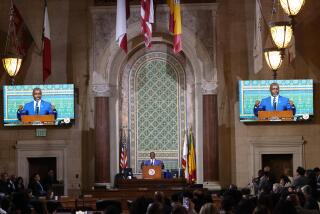SANTA CLARITA / ANTELOPE VALLEY : Keeping a Close Eye on City Council : Government: Although sometimes a thorn in the side of Santa Clarita officials, self-appointed watchdogs play a key role in municipal affairs.
SANTA CLARITA — It’s a routine Tuesday night City Council meeting. But like die-hard fans at the end of a losing season, a handful of citizens show up anyway.
A large man wearing a dark gray suit sits at one end of the second row, filling out requests to address the council on several topics. He treats the room like a second home, adjusting the thermostat and moving portable seats and folding tables out of his way.
“I’m frankly astonished more people don’t attend City Council meetings,” said Allan Cameron, 47, a brown-haired bear of a man who, wedged into one of the chamber seats, looks like an adult sitting in a child’s desk. “I don’t think it’s because people don’t care. I think that they have an uneasy hope that their interests are being protected.”
Cameron, a development consultant, is one of a handful of self-appointed watchdogs who faithfully attend the city’s many public meetings. Gadfly, a label fixed on city hall regulars in some cities, would be too unkind, too out of place, here.
Most of the regulars are retired and seldom combative. Most became involved during Santa Clarita’s cityhood drive in the late 1980s. Santa Clarita broke away from county rule when it was incorporated in December, 1987.
Although some city officials say they are growing tired of their constant scrutiny, one council watcher defended his work, saying, “They need us because they need to put up a good front of democracy and democracy includes public input.”
Cameron began his participation in Santa Clarita Valley affairs during the mid-1970s when the Los Angeles County Board of Supervisors considered building a prison in the valley. The 18-year Canyon Country resident said he has attended 80% of the city’s public meetings held in the past six years.
“I wouldn’t say there was a single, precipitous issue that drew me in. It was more of a trend. As the city began to start, I had a sort of proprietary interest in it,” Cameron said.
Cameron is officious and verbose. But he often knows more about the issue at hand than the designated decision-makers. Despite longstanding ties to the building industry, he is a staunch supporter of environmental causes and has been known to advise city officials on how to bargain effectively with former clients.
Santa Clarita’s activists have played an important role in the city’s decision-making, said Cameron, who bristles at any generalization of city watchdogs as eccentrics or kooks.
“The human mind likes to come up with easy categories for people,” Cameron said. “It chops off the rough edges of life and allows them to set up a mental filing cabinet. It’s not that simple, though.”
In the front row, a retired engineering designer colors a stack of photocopied maps that he will soon distribute to the council, marking the pages in shades of pink, green and yellow. He wears a pale-green V-necked sweater and gray slacks. He shuffles his feet when he approaches the podium to speak.
“I’m disappointed that the room isn’t filled at every meeting,” said Jack Ancona, 67. “It’s a sad statement on our society that people are not interested in the government until it’s stepping on their toes.”
Ancona started his activism in 1979, fighting a dump proposed for the Sand Canyon community. Ten years later, he joined opponents of a landfill proposed in nearby Elsmere Canyon.
“I think that’s what keeps me going,” said Ancona, a soft-spoken man who resides in Canyon Country. “I don’t like all the secret stuff that is going on.”
Ancona and Cameron are only two of the Santa Clarita watchdogs who possess a surprisingly strong technical background on city matters. Their peers include:
* Ed Dunn, 61, a former aerospace manager and one-time watchmaker. He and his wife, Joan, usually attend meetings of the City Council and the Castaic Lake Water Agency.
“We try to go with the truth and nobody owns us, so we can sleep at night,” said Dunn, a 24-year resident who participated in the drafting of Santa Clarita’s General Plan.
* Bob Lathrop, a retired mechanical engineer for Lockheed. The Newhall resident acted as a media spokesman for the group that authored Measure A--a failed proposal to put annual limits on new home construction. He is highly critical of Santa Clarita’s largest developer, the Newhall Land & Farming Co.
“I was retired and I was interested and had heard of skulduggery going on, so I decided to go to meetings and get informed,” Lathrop said.
Santa Clarita officials say watchdogs are a byproduct of local government. Unlike decisions made at the federal, state and county levels, rulings by local agencies often have an immediate effect on residents, said Gail Foy, the city’s public information officer.
“People don’t realize that local government has the most direct impact on their lives,” Foy said. “We laugh and joke about people who regularly attend meetings, but they serve an important purpose.”
Although they encourage citizen participation, Santa Clarita officials sometimes become impatient with their recurring visitors. They complain that activists criticize without offering solutions and repeatedly dredge up the same issues.
Jo Anne Darcy, who serves on both the Santa Clarita City Council and as a field deputy for County Supervisor Michael Antonovich, cited the scuttling of California 126 in October as an example.
The eight-lane expressway proposal went through more than 2 1/2 years of public discussion before the idea was brought to the Santa Clarita City Council.
So elected officials were surprised when just days before the deadline to close public comments on the state project, hundreds of residents packed the council chambers and demanded more time to discuss the issue.
Vera Johnson, 66, a regular City Council attendee, stopped participating in recent weeks. The 28-year Newhall resident, who ran unsuccessfully for the Santa Clarita City Council in 1992, said she is discouraged from participating any more because city officials discriminate against activists.
“I went for four years from dawn to dusk and felt my testimony was disregarded and, in fact, sometimes they would go against it because it was from Vera Johnson,” she said.
Darcy conceded that the council may be paying less attention to the local activists.
“There may be developing an apathy from dealing with the same people,” Darcy said. “We always seem to perk up when we see a new face.”
Ancona agreed that activists are often disregarded, but said council members, for the most part, still listen.
Johnson said there is probably only one reason for that: “If we stopped going, they would be talking to an empty hall.”
More to Read
Sign up for Essential California
The most important California stories and recommendations in your inbox every morning.
You may occasionally receive promotional content from the Los Angeles Times.









